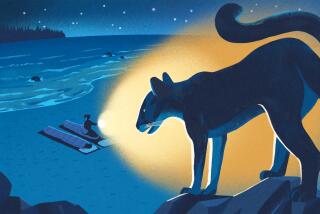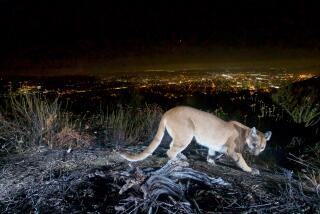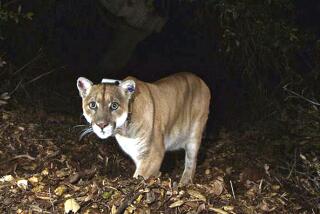Hunter Remembers Thrill of Tracking the Big Cats : Excitement of the Chase Kept Him on Cougars’ Trail
Retired Santa Ana dentist Perry Davis always looked forward to getting phone calls from his pal Leo F. Douglass.
Douglass, a pioneer Anaheim orange grower, had the reputation of being Orange County’s foremost mountain-lion hunter. And at least twice a month in the ‘60s and early ‘70s, Douglass would call to ask Davis to accompany him and his hound dogs up into the Santa Ana Mountains for a day of hunting the big cats.
Although he started hunting mountain lions in the 1940s, Davis has bagged only about 18 of the cougars, as they are commonly called.
But it was always the excitement of the hunt more than the kill that kept him interested.
“The mountain lion is a grand animal, and to see one is still a thrill,” Davis, 80, said. “There is not one person in a hundred thousand that sees a mountain lion in its natural habitat.”
Douglass’ and Davis’ forays for mountain lions ended in 1972 when a statewide moratorium was placed on hunting the animals. But that ban will be lifted if a proposal unveiled earlier this week by the state Fish and Game Department is approved. The plan will be presented to the California Fish and Game Commission today in Long Beach and is not expected to be acted upon for several weeks.
Hunting Season
The plan, which has outraged animal protection groups, calls for a 79-day hunting season for mountain lions, which could result in the killing of as many as 210 of the animals statewide, beginning in October. State officials said they believe that the taking of 210 lions a year would have little or no effect on the lion population. They estimate that only 5% to 30% of the hunters would be successful, which means somewhere from 10 to 63 of the state’s estimated 5,100 lions would actually be killed.
The hunters would be selected from a lottery for one of the 210 mountain-lion permits, which would cost $75. Hunters in Orange County, one of five hunting zones, would be allowed to kill 20 cats.
Davis is pleased with the proposal. “I see there is no valid objection to having a limited number of permits to take a certain number of lions, which are surplus,” he said.
Bob McKay of Ventura, president of both the California Wildlife Federation and its activist arm, the California Sportsman’s Lobby, agreed: “If there is a manageable surplus (of mountain lions), then sports hunting is the most cost-effective way of controlling excess population.”
McKay, whose nonprofit organization has approximately 150,000 sportsmen as members, said he would not sign up for the lottery because he has hunted cougars and wants to give some one else the experience.
“It is very exciting when you see a cat in the wild,” he said. “I have never seen one yet that has not caused the heart to pound. There is an excitement with seeing this critter, and it does seem to take you back to prehistoric times. It puts the human in perspective with what he really is if he faces one out in the wild, and it does make you feel very small.”
Although the trim, vigorous Davis hasn’t been hunting in several years, he is considering entering the lottery if the plan is approved.
“I’m past the point where my enjoyment of the hunt depends on taking a lion,” said Davis, whose friend Douglass died six years ago at age 89. “All I want to do is get in on the hunt and enjoy it.”
Davis clearly enjoys hunting, as his large trophy room in Santa Ana attests. More than 50 heads and skins adorn the walls--from rhinoceros and leopard from Africa to deer from Utah and moose from Alaska. On the floor are bear and lion skin rugs and an elephant’s foot, which serves as a TV stand.
“Here is a California mountain lion that came from Old Benton, Calif.,” Davis said, pointing to a golden brown pelt on the wall. “I’ve probably been on a dozen to 18 lion catches.”
Dogs Used for Tracking
An adult mountain lion weighs about 135 pounds and is about five feet long, with an equally long tail. Because the swift animals travel over large distances, dogs are used to track them. The barking dogs will run a cat up a tree and keep it there until the hunter arrives.
Davis, who once owned a 160-acre ranch in Utah where he hunted mountain lions and deer, acknowledged that keeping up with a pack of hound dogs takes a lot of endurance.
But, he said, “there’s an art to keeping up with hound dogs. You don’t follow in the hounds’ tracks all the time--you take shortcuts. And a lot of time you’re listening and sitting. You follow the hound dogs when they’re on a hot scent, but other than that you let the dogs do the work. I’ve seen very old men that can follow a hound dog just as well as a young person.”
Even if hunters are able to keep up with the dogs, there’s no guarantee they will be successful. Davis figures that he and Douglass went mountain-lion hunting in the local mountains several hundred times over the years.
But, he said, “nearly all those trips were what you’d call dry runs except for (shooting) about two or three lion and a dozen bobcats over the years. But that doesn’t mean we didn’t enjoy it and gave the dogs a workout.”
Davis said the Santa Ana mountains usually are dry, which makes it more difficult for dogs to pick up a scent. And because it is such rough canyon country, it is difficult to get around on a horse which can cover more miles than men on foot.
Furtive Cats
Above all, he said, mountain lions are difficult to bag because the big cats are so furtive.
McKay agrees.
“They’re a very secretive animal,” he said. “They can disappear in cover that you’d think would be impossible. In the summer when wild oats turn brown, I watched a mountain lion walk into a patch of wild oats the size of the average living room. That cat crouched down when it saw me and crawled out of there. I’m a very experienced wildlife observer, and I never saw that cat walk out of there.”
Although McKay acknowledged that the proposed limited mountain-lion hunting season in California pleases many hunters, he doesn’t think many hunters will rush out to sign up for the permit lottery.
“I think they realize it’s just a very, very difficult animal to hunt,” he said. “And there’s very few--probably 600 hounds men--in the state with good hounds. Other than people with experienced dogs, it’s going to be very difficult to get a lion.
“For a hunter to set out on foot or to specifically go out after a mountain lion without the aid of dogs, what he’s really going to get is a nice walk in the outdoors.”
Like many hunters, McKay said, hunting mountain lion for him was “incidental to hunting deer or being up in the mountains with my rifle.”
“I never went out of my way intentionally to hunt mountain lions,” he said. “It was never a priority animal with the hunter. You just did not see that many there, and even among the hounds men, they are more interested in the chase.”
In fact, Davis said he hunted mountain lion for 10 years before he ever bagged one. Many factors can cause the chase to go awry.
He recalled the time he and Douglass were on the track of a female cat that had killed a jack rabbit. The cat’s cub was dragging the rabbit by the leg along the trail and, he said, “the scent was red hot. We had four hound dogs on it. Everything was ideal. But a heavy thunderstorm broke. It washed out all the tracks and all the scent.”
Davis was introduced to Douglass in 1937, three years after opening his dental practice in downtown Santa Ana. Davis recalled: “They told me he was a hunter, had a four-wheel-drive outfit, kept four good hound dogs and”--he laughed--”was a good cook.”
Hunted in Canyons
Davis said he and Douglass went to Utah five times and three times to Oregon to hunt and about 25 or 30 times a year in the Santa Ana Mountains.
“We’d go up to Black Star Canyon, Freemont Canyon and then clear across the mountains to Bell Canyon, Santiago Canyon and Trabuco Canyon,” he said. “He knew all the trails and crossings the lions followed.”
Davis recalled that Douglass sometimes would drag brush behind his truck to smooth down a sandy trail. The next day they’d check the trail to see if there were any fresh lion tracks in the sand. “If there were, you knew you had a track less than 24 hours old and that’s good enough to trail.”
Although two children were mauled by mountain lions in Ronald W. Caspers Wilderness Park in southeastern Orange County last year, both McKay and Davis say it is rare that a mountain lion will attack a human.
McKay acknowledged, however, that if one did attack, “a person would absolutely not have a chance.”
The mountain lion is one of the fastest animals on earth, capable of covering 100 yards in three seconds, he said. “But their mode of operation is to escape, not attack.”
Davis, however, has had some hair-raising encounters with the big cats.
One time, he recalled, the dogs ran past the lion they were chasing.
“I came along and found the lion in the tree, and the dogs were a mile ahead,” he said. “I stood right under the tree, and the lion jumped out and hit the ground running and went up another tree.”
Another time, he said, “the dogs were way ahead of me. I stood about 50 feet from a tree and heard the dogs’ barking coming toward me. The lion showed up and leaped 20 feet for the tree. But his aim wasn’t too good. He had to grab hold of the tree with both front feet and went clear around the tree. His front claws clawed off a whole shower of bark that went all over me.”
That, he admitted with a grin, “was a thrill to see him jump toward me.”
More to Read
Sign up for Essential California
The most important California stories and recommendations in your inbox every morning.
You may occasionally receive promotional content from the Los Angeles Times.









